Panasonic Lumix G Vario 45-150mm f/4.0-5.6 Lens Review
Panasonic Lumix G Vario 45-150mm Performance
Sharpness in the centre of the frame is already excellent at 45mm with good sharpness produced towards the edges of the frame at maximum aperture. Images taken at f/5.6 yield the highest levels of clarity in the centre of the frame although sharpness towards the edges of the frame never quite reaches the same high remaining between good and very good levels of clarity from maximum aperture down to f/11.Zooming to 75mm results in an increase in sharpness to very good levels towards the edges of the frame at maximum aperture. Sharpness in the centre remains excellent, peaking as the lens is stopped down to f/5.6.
Finally, as is typical with lenses covering this range, clarity falls off as the lens is zoomed to the telephoto end of the range. At maximum aperture, sharpness is good in the centre and just short of good levels towards the edges of the frame. The highest levels of clarity across the frame are achieved with the lens stopped down to between f/8 and f/11, where sharpness in the centre approaches very good levels, and good clarity is achieved towards the edges of the frame.
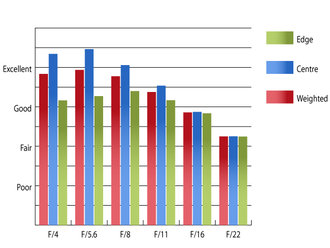 Resolution @45mm | 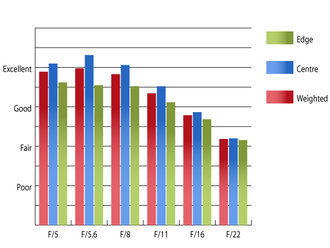 Resolution @75mm | |
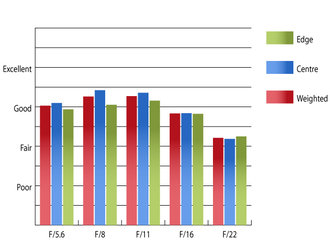 Resolution @150mm | How to read our chartsThe blue column represents readings from the centre of the picture frame at the various apertures and the green is from the edges. Averaging them out gives the red weighted column.The scale on the left side is an indication of actual image resolution. The taller the column, the better the lens performance. Simple. For this review, the lens was tested on a Panasonic Lumix DMC-G3 using Imatest. |
Chromatic aberrations are kept well within acceptable levels throughout the zoom range, with fringing never exceeding half a pixel width at any aperture or zoom setting. These low levels of fringing should allow large prints, or harsh crops from near the edges of the frame to be made without hesitation.
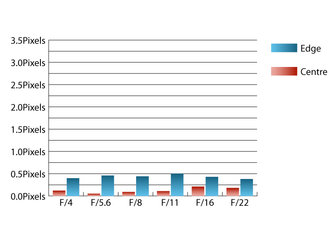 Chromatic aberration @45mm | 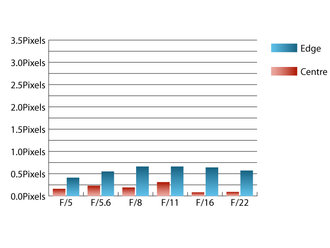 Chromatic aberration @75mm | |
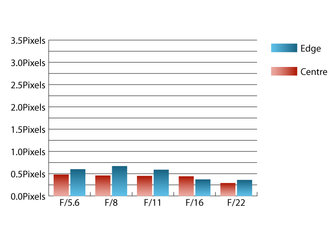 Chromatic aberration @150mm | How to read our chartsChromatic aberration is the lens' inability to focus on the sensor or film all colours of visible light at the same point. Severe chromatic aberration gives a noticeable fringing or a halo effect around sharp edges within the picture. It can be cured in software.Apochromatic lenses have special lens elements aspheric, extra-low dispersion etc. to minimize the problem, hence they usually cost more. For this review, the lens was tested on a Panasonic Lumix DMC-G3 using Imatest. |
Falloff of illumination towards the corners is reasonably controlled, with the corners being 1.59 stops darker than the image centre at 45mm, and 1.6 stops darker at 150mm. Visually uniform illumination is achieved with the lens stopped down by two stops from maximum aperture throughout the zoom range.
Distortion is extremely well controlled, with Imatest only recording 0.125% barrel distortion at 45mm and 0.238% pincushion at 150mm. These levels are so low they will be virtually imperceptible in most shooting scenarios. If absolutely straight lines are paramount, then what little distortion is there should be relatively straightforward to correct, as the distortion pattern is uniform across the frame.
A deep circular hood is supplied as standard, which does an excellent job of shielding the front element from extraneous light that may cause a loss of contrast, or flare. Even when shooting into the light, contrast levels hold up well, only being reduced slightly at 150mm and maximum aperture.
Add your message
Login required
Please login here or if you've not registered, you can register here. Registering is safe, quick and free.
Please login here or if you've not registered, you can register here. Registering is safe, quick and free.
photodo Stats
1102 lenses
428 MTF tests
74 in-depth photodo reviews
100+ users join each day
Help the lens community by reviewing or rating a lens today via our lens search
428 MTF tests
74 in-depth photodo reviews
100+ users join each day
Help the lens community by reviewing or rating a lens today via our lens search
Latest Lens Reviews
- Chinon 28mm f/2.8 Vintage Lens Review
- Canon EF 70-200mm f/4L IS II USM Lens Review
- Samyang AF 85mm f/1.4 EF Review
- Sigma 70mm f/2.8 DG Macro Art Review
- Samyang AF 24mm f/2.8 FE Review
- Meike 50mm f/1.7 Review
- Tamron 70-210mm f/4 Di VC USD Review
- Lensbaby Burnside 35mm f/2.8 Review
- Asahi Super Takumar 50mm f/1.4 Review
- Asahi Super-Multi-Coated Takumar 135mm f/3.5 Review
